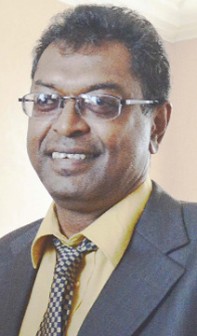AFC Leader Khemraj Ramjattan has expressed concern that there may be “fundamental breaches” of the Guyana-Norway forest protection agreement as it relates to the Amaila Falls Hydropower Project (AFHP) and has called for the release of information.
“…it is in the public interest of Norwegians and Guyanese to know what is happening between Norway and (the Inter-American Development Bank) IDB especially so when firstly, our National Assembly has been undemocratically prorogued with the consequence that it will not be in session so as to permit our Parliamentarians to call on our Ministers to account and explain,” Ramjattan said in a letter to the Director of Norway’s International Climate and Forest Initiative, Per Fedrik Pharo.

In the letter, dated December 24, 2014, which was obtained by Stabroek News, Ramjattan said that the AFC is very concerned that there may be violations and fundamental breaches of the Norway-Guyana Agreement. Guyana and Norway have a five-year pact under which Oslo will pay up to US$250 million based on Guyana’s efforts in protecting its forest and meeting enabling indicators. The pact came to an end at the end of 2014 but government has not moved swiftly to submit projects for funding and a substantial sum remains in the Guyana REDD+ Investment Fund (GRIF).
In his New Year’s address, President Donald Ramotar said that “within months” the government expects to achieve financial closure and the start of construction of the AFHP. He had announced that Oslo has transferred US$80M to the Inter-American Development Bank (IDB).
The transfer of the funds outside of the GRIF as well as the fact that the project is moving ahead in the absence of the National Assembly has raised a number of questions among observers. Among others, questions have been raised about the transparency as well as the secrecy surrounding the project.
The intended developer, Sithe Global, pulled out of the AFHP in August 2013 citing a lack of political consensus. The company had issued explicit statements that unless all three parties in Parliament backed two measures for the controversial US$858 million project it would pull out. The measures were not fully supported and the company walked away.
Since the project was first announced, costs of the 165-megawatt hydro venture have escalated from the original US$450M to US$858.2M up to last year. Recently, it was also revealed that the costs for the access road had ballooned from US$15M when the contract was signed in 2010 to US$41M last year.
Procedural requirements
In his letter to Pharo, Ramjattan recalled that former President Bharrat Jagdeo intended that Guyana should acquire a US$80 million equity in the AFHP which he had indicated would be funded from monies flowing from the Norway-Guyana Agreement. Ramjattan noted that under that agreement, Norway had agreed to only fund such a project under Guyana’s Low Carbon Development Strategy provided that two procedural requirements are met, namely, that there is a project proposal properly delineating all aspects of the project and which is endorsed as economically and environmentally viable by an international intermediary, in this case the IDB; and, that the said project proposal is put out to the public for meaningful public consultation and scrutiny.
“These two requirements were underlying principles of any project under consideration under the 2009 Agreement for very good reasons – transparency and accountability,” Ramjattan wrote. “The benefactors of these REDD-plus funds who are taxpayers of Norway did not want Norway’s monies to go waste on any ill-advised, uneconomical venture through the auspices of a corrupt beneficiary Government,” he added.
Ramjattan pointed out that to date, no such project proposal for the AFHP from the Office of Climate Change in the Office of the President has been prepared, nor submitted for public consultation. Additionally, technical appraisal missions from the IDB in early 2011 have not resulted in any public document which supports the extraordinarily high-cost of the dam, he asserted.
The AFC leader said that moreover, after the withdrawal of the licence-holding project developer Sithe Global Power LLC in 2013, it was expected that this idea of purchase of equity for the project would have been dropped.
“From all appearances it seems it has not, because Norway has continued its discussions with the IDB on this project on the prompting, as I have been reliably informed, by Mr. Jagdeo, who is now a private citizen,” Ramjattan wrote. Citing Norway’s Freedom of Information Law, he requested access to the correspondence between Norway and the IDB as well as the project proposal and all documentation pertaining to this project.
“I do so in the firm knowledge that it is in the public interest of Norwegians and Guyanese to know what is happening between Norway and IDB especially so when firstly, our National Assembly has been undemocratically prorogued with the consequence that it will not be in session so as to permit our Parliamentarians to call on our Ministers to account and explain; and, secondly, when our Guyanese Commissioner of Information, one Mr. Charles Ramson SC, will be so haplessly helpless in providing same,” Ramjattan said.
He added that he had reason to believe that negotiations between Norway and the IDB are at a critical stage.
Prior to obtaining Ramjattan’s letter, Stabroek News had obtained a letter dated November 11, 2014 from Pharo to President of the IDB Luis Alberto Moreno. Pharo had requested the IDB to receive a grant contribution of US$80 million no later than December 12, 2014, that will enable the Government of Guyana to satisfy its equity obligations under the Project. The Norwegian authorities denied several other requests for documentation relating to the project. According to documentation seen by this newspaper, requests for information by at least one other publication on the AFHP had also been denied.





